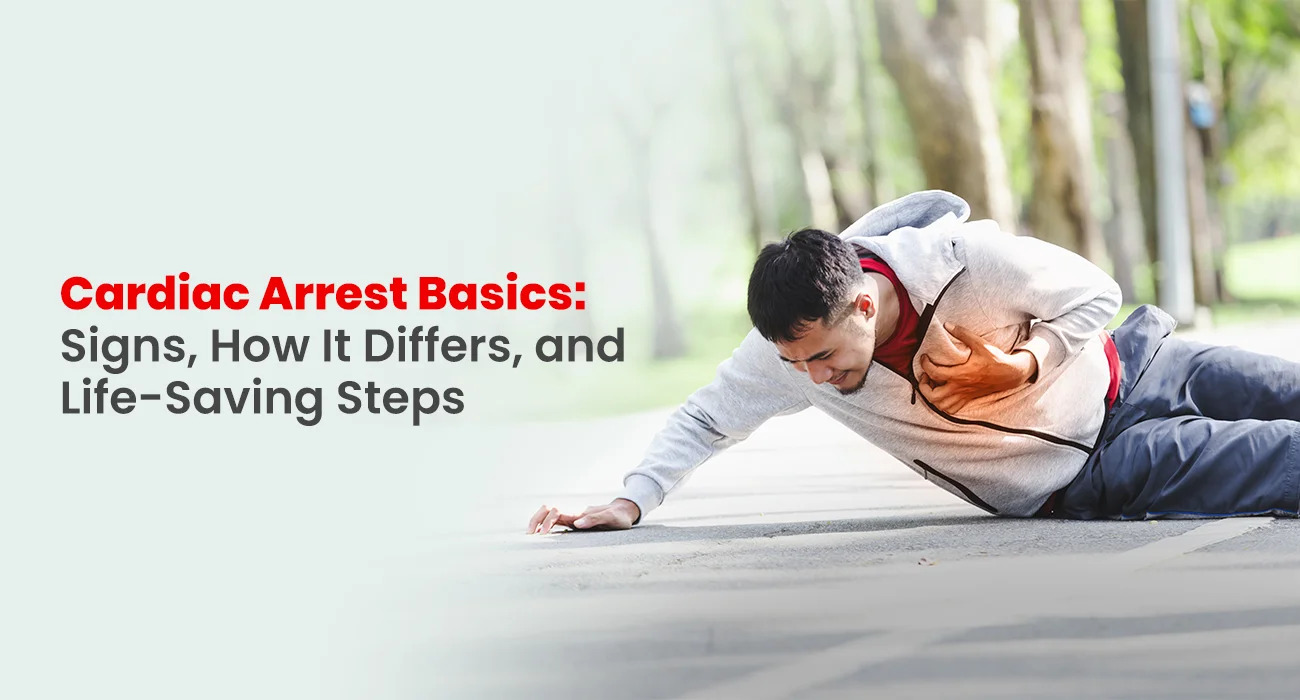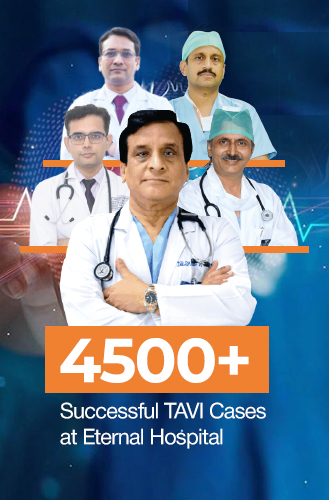Cardiac Arrest Basics: Signs, How It Differs, And Life-Saving Steps
06/30/2025
Sudden cardiac arrest is one of the most dangerous medical emergencies, often striking with little warning. It matters every minute when it does. While many people confuse cardiac arrest with heart attack, the two are separate but both in cause and how we must respond. Knowing this difference, recognizing cardiac arrest warning signs, and what to do immediately can be a lifesaver.
This book will help you know what cardiac arrest is, how it differs from heart attack, early warning signs, first aid processes like CPR and emergency response that will increase the survival chance of a person.
What Is Cardiac Arrest?
Cardiac arrest is when the heart is no longer pumping blood. This means that there is no blood being sent to the brain and organs. If it is not treated with CPR (cardiopulmonary resuscitation) or defibrillation right away, it leads to death within a few minutes.
Key Characteristics:
- Sudden loss of consciousness
- No heartbeat or pulse
- No breathing
It most often happens due to an electrical malfunction in the heart that disrupts its pumping action. The most common underlying reason is an arrhythmia called ventricular fibrillation.
How Is Cardiac Arrest Different From a Heart Attack?
Both are life-threatening illnesses but are not the same thing.
Heart Attack
A heart attack, or myocardial infarction, occurs when blood to part of the heart muscle is cut off, usually by a blockage caused by a clot. The heart continues to beat but is injured.
Cardiac Arrest
This is an electrical malfunction, where the heart simply stops beating. Sometimes this occurs as a result of a heart attack, but other times it happens suddenly without warning.
Feature Heart Attack Cardiac Arrest
Cause Blocked blood flow Electrical malfunction
Consciousness Often conscious Unconscious
Pulse Present (usually) Absent
Breathing Difficult but possible Not breathing
Immediate Treatment
Medications, stenting
CPR, defibrillation
What Are the Warning Signs of Cardiac Arrest?
Cardiac arrest usually strikes suddenly, but for some, warning signs do occur hours or days beforehand. Recognizing these signs may provide an opportunity to seek help.
Possible Early Warning Signs:
- Sudden fall
- No heartbeat or pulse
- No response or breathing
- Chest pain
- Shortness of breath
- Weakness or fatigue
- Palpitations or abnormal heart rhythm
- Dizziness or fainting
In some, cardiac arrest occurs suddenly, with no warning symptoms at all—especially in young, otherwise healthy individuals.
What Causes Sudden Cardiac Arrest?
There are numerous underlying conditions that lead to sudden cardiac arrest. They are:
- Coronary artery disease (most common)
- Heart attack (can trigger arrest)
- Cardiomyopathy (wide heart)
- Inherited arrhythmias (e.g., Long QT syndrome)
- Heart failure
- Valvular heart disease
- Severe electrolyte disturbances
- Drug or trauma overdose
Cardiac Arrest in Different Populations
1. In Adults
Most of the cases are due to heart attack or coronary artery disease. Men aged more than 45 years are at higher risk, especially with high blood pressure, diabetes, or overweight.
2. In Children or Adolescents
It is rare but can occur due to congenital heart defects or unrecognized electrical heart conditions.
3. During Exercise
Excessive exercise may lead to cardiac arrest, especially in people with any pre-existing heart condition.
First Aid for Cardiac Arrest: Life-Saving Actions
Prompt response is vital. Every minute of delay reduces the probability of survival by 10%.
Step 1: Check for Responsiveness
Lightly shake or tap the person.
Shout at the top of your voice, "Are you alright?"
If not responding, go to step 2.
Step 2: Call Emergency Services
- Dial your local emergency services number (e.g., 108 in India).
- Call for an ambulance and tell them that it is a suspected cardiac arrest.
Step 3: Begin CPR Right Away
- Push hard and fast in the center of the chest (100–120 compressions/min).
- If trained, give 2 rescue breaths after every 30 compressions.
- Don't stop until help or an AED arrives.
Step 4: Operate an AED (If Available)
- An Automated External Defibrillator (AED) will restore normal rhythm.
- Turn it on and follow the voice prompts.
- Why CPR Training Is Important
Many lives will be saved if more people know how to perform CPR. It stands to double or even triple the cardiac arrest victim's chance of survival if performed early.
Benefits of CPR Training
- Boosts confidence during emergencies
- Allows for faster response before getting help arrives
- Reduces fear of not feeling like helping someone
- Instills health awareness in the community
The majority of organizations today offer CPR training, including schools, colleges, and the work environment.
Cardiac Arrest Prevention Tips
You can lower your risk of cardiac arrest with healthy lifestyle changes and early screening.
1. Regular Checkups
- Have your blood pressure, cholesterol, and blood sugar checked.
- If you have heart disease, stay consistent with medications.
2. Healthy Diet
- Consume less salt, sugar, and trans fats.
- Eat plenty of fruits, vegetables, and lean protein.
3. Regular Exercise
- At least 30 minutes of walking, 5 days a week.
- Do not over-work, especially if there is heart disease in your lineage.
4. Quit Smoking & Limit Alcohol
- Smoking is bad for blood vessels and leads to sudden cardiac arrest.
5. Stress Reduction
- Practice yoga, mindfulness, or meditation to lower heart stress.
- Home or Workplace Response to Cardiac Arrest
Does not matter if it occurs at home, office, or public area; being prepared can be life-saving.
Have an Action Plan for Cardiac Emergency:
- Show emergency contact numbers
- Identify people who are certified in CPR
- Know the location of the AED (if it exists)
- Conduct regular drills in schools or the workplace
Survival Rates & Recovery
Survival rates for cardiac arrest are low—below 12% on average—but can be greatly increased with early aid.
Recovery Is Based On
- How quickly CPR and defibrillation had been activated
- Whether or not the person had underlying health conditions
- The quality of post-resuscitation care (ICU, medication, etc.)
Cardiac Arrest FAQs
Q. Can cardiac arrest strike suddenly?
A: Yes, suddenly in seemingly healthy people, although a few experience early and mild symptoms.
Q. Is cardiac arrest always fatal?
A: No. Prompt CPR and defibrillation rescue many who then fully recover.
Q. What is the difference between cardiac arrest and stroke?
A: Stroke affects the brain due to impaired circulation of blood, while cardiac arrest is a sudden stoppage of the heart.
Q. Is cardiac arrest reversible?
A: Yes, but only if immediately treated with CPR and AED.
Q. Who is most at risk for sudden cardiac arrest?
A: Those with prior history of heart attack, heart failure, arrhythmias, or with family history of sudden death.
Conclusion
Cardiac arrest is an emergency that mandates a rapid, informed reaction. Knowing the warning signs, acting quickly with CPR, and calling for help can mean the difference between life and death.
Educating yourself, promoting CPR training, and embracing a heart-healthy lifestyle are among the best ways we can reduce cardiac arrest death.
Wherever you may be—home, school, office—be ready. Because when you're having a cardiac emergency, every second counts.



 +91-9166096099
+91-9166096099